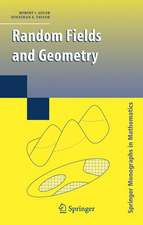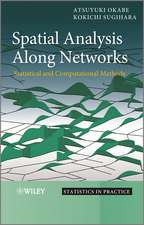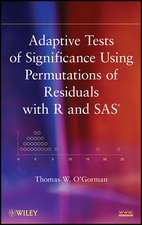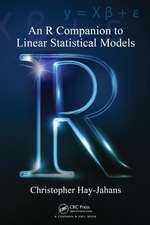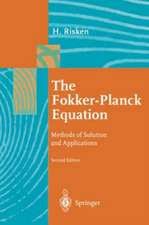Graphical Methods for the Design of Experiments: Lecture Notes in Statistics, cartea 143
Autor Russell R. Bartonen Limba Engleză Paperback – 5 aug 1999
Din seria Lecture Notes in Statistics
- 15%
 Preț: 631.86 lei
Preț: 631.86 lei -
 Preț: 385.84 lei
Preț: 385.84 lei - 17%
 Preț: 490.19 lei
Preț: 490.19 lei - 17%
 Preț: 460.28 lei
Preț: 460.28 lei - 18%
 Preț: 945.92 lei
Preț: 945.92 lei - 20%
 Preț: 561.42 lei
Preț: 561.42 lei - 18%
 Preț: 943.25 lei
Preț: 943.25 lei - 18%
 Preț: 943.25 lei
Preț: 943.25 lei - 18%
 Preț: 995.97 lei
Preț: 995.97 lei - 15%
 Preț: 641.38 lei
Preț: 641.38 lei -
 Preț: 436.14 lei
Preț: 436.14 lei - 15%
 Preț: 633.53 lei
Preț: 633.53 lei - 15%
 Preț: 658.88 lei
Preț: 658.88 lei -
 Preț: 383.33 lei
Preț: 383.33 lei - 15%
 Preț: 640.71 lei
Preț: 640.71 lei - 18%
 Preț: 947.18 lei
Preț: 947.18 lei - 18%
 Preț: 1007.35 lei
Preț: 1007.35 lei - 18%
 Preț: 942.63 lei
Preț: 942.63 lei - 15%
 Preț: 639.59 lei
Preț: 639.59 lei - 18%
 Preț: 1231.47 lei
Preț: 1231.47 lei - 15%
 Preț: 643.00 lei
Preț: 643.00 lei - 18%
 Preț: 886.62 lei
Preț: 886.62 lei -
 Preț: 383.12 lei
Preț: 383.12 lei - 15%
 Preț: 633.35 lei
Preț: 633.35 lei - 15%
 Preț: 635.65 lei
Preț: 635.65 lei -
 Preț: 393.74 lei
Preț: 393.74 lei - 15%
 Preț: 632.70 lei
Preț: 632.70 lei - 15%
 Preț: 637.28 lei
Preț: 637.28 lei - 15%
 Preț: 702.87 lei
Preț: 702.87 lei - 15%
 Preț: 642.68 lei
Preț: 642.68 lei - 15%
 Preț: 644.63 lei
Preț: 644.63 lei - 15%
 Preț: 645.14 lei
Preț: 645.14 lei -
 Preț: 382.36 lei
Preț: 382.36 lei - 15%
 Preț: 636.30 lei
Preț: 636.30 lei - 15%
 Preț: 647.92 lei
Preț: 647.92 lei -
 Preț: 380.63 lei
Preț: 380.63 lei - 18%
 Preț: 887.05 lei
Preț: 887.05 lei - 15%
 Preț: 634.32 lei
Preț: 634.32 lei - 15%
 Preț: 648.74 lei
Preț: 648.74 lei -
 Preț: 378.92 lei
Preț: 378.92 lei - 15%
 Preț: 648.56 lei
Preț: 648.56 lei - 15%
 Preț: 647.59 lei
Preț: 647.59 lei - 18%
 Preț: 780.37 lei
Preț: 780.37 lei - 15%
 Preț: 641.20 lei
Preț: 641.20 lei - 18%
 Preț: 1102.69 lei
Preț: 1102.69 lei - 15%
 Preț: 643.16 lei
Preț: 643.16 lei -
 Preț: 384.70 lei
Preț: 384.70 lei
Preț: 692.74 lei
Preț vechi: 814.99 lei
-15% Nou
Puncte Express: 1039
Preț estimativ în valută:
132.57€ • 136.95$ • 110.33£
132.57€ • 136.95$ • 110.33£
Carte tipărită la comandă
Livrare economică 25 martie-08 aprilie
Preluare comenzi: 021 569.72.76
Specificații
ISBN-13: 9780387947501
ISBN-10: 0387947507
Pagini: 196
Ilustrații: X, 196 p. 9 illus.
Dimensiuni: 155 x 235 x 11 mm
Greutate: 0.3 kg
Ediția:1999
Editura: Springer
Colecția Springer
Seria Lecture Notes in Statistics
Locul publicării:New York, NY, United States
ISBN-10: 0387947507
Pagini: 196
Ilustrații: X, 196 p. 9 illus.
Dimensiuni: 155 x 235 x 11 mm
Greutate: 0.3 kg
Ediția:1999
Editura: Springer
Colecția Springer
Seria Lecture Notes in Statistics
Locul publicării:New York, NY, United States
Public țintă
ResearchCuprins
1 Introduction.- The role of experiment design in statistical methodology.- The five main steps in the design of an experiment.- Summary of topics.- The videodisk pressing example.- Study questions.- 2 Planning for a Designed Experiment.- Goal hierarchy plots.- Individual experiment goals and form of the statistical model.- Experiment goals: other aspects.- Key terms in experiment design.- Identifying and classifying variables.- Choosing a model: a priori main effect and interaction plots.- Summary.- Study questions.- 3 Design-Plots for Factorial and Fractional-Factorial Designs.- Factorial designs.- Graphical presentation of factorial designs.- Factorial designs and corresponding regression models.- Graphical projections and the notion of effect sparsity.- Confounding in fractional-factorial designs.- Geometric patterns of confounding relations.- Design-plots for other designs.- Study questions.- 4 Designing Experiments Graphically.- Constructing two-level fractional-factorial designs.- Designing fractional-factorial experiments with three or more levels.- Videodisk pressing example.- Graphical design of mixture experiments.- Graphical designs for blocking and nested effects.- Confounding graphs.- Experiment designs for robust design.- Designing pilot experiments.- Study questions.- 5 Assessing Experiment Designs.- A videodisk experiment design.- Numerical measures for design assessment.- Design assessment and `optimal’ designs.- Graphical methods for assessing confounding in regular 2k-pdesigns.- Prediction error plots.- Designs for a manufacturing simulation study.- Shaded-block matrix plots.- Parallel coordinate plots.- A model with dependent random perturbations.- Study questions.- 6 Presenting Results Graphically.- Traditional graphical displays of experimentalresults.- Response-scaled design-plots.- Constructing a response-scaled design-plot.- Interpreting response-scaled design-plots.- Response-scaled design-plots and robust design.- Model-free interpretation of experimental results.- Study questions.
Caracteristici
Includes supplementary material: sn.pub/extras





